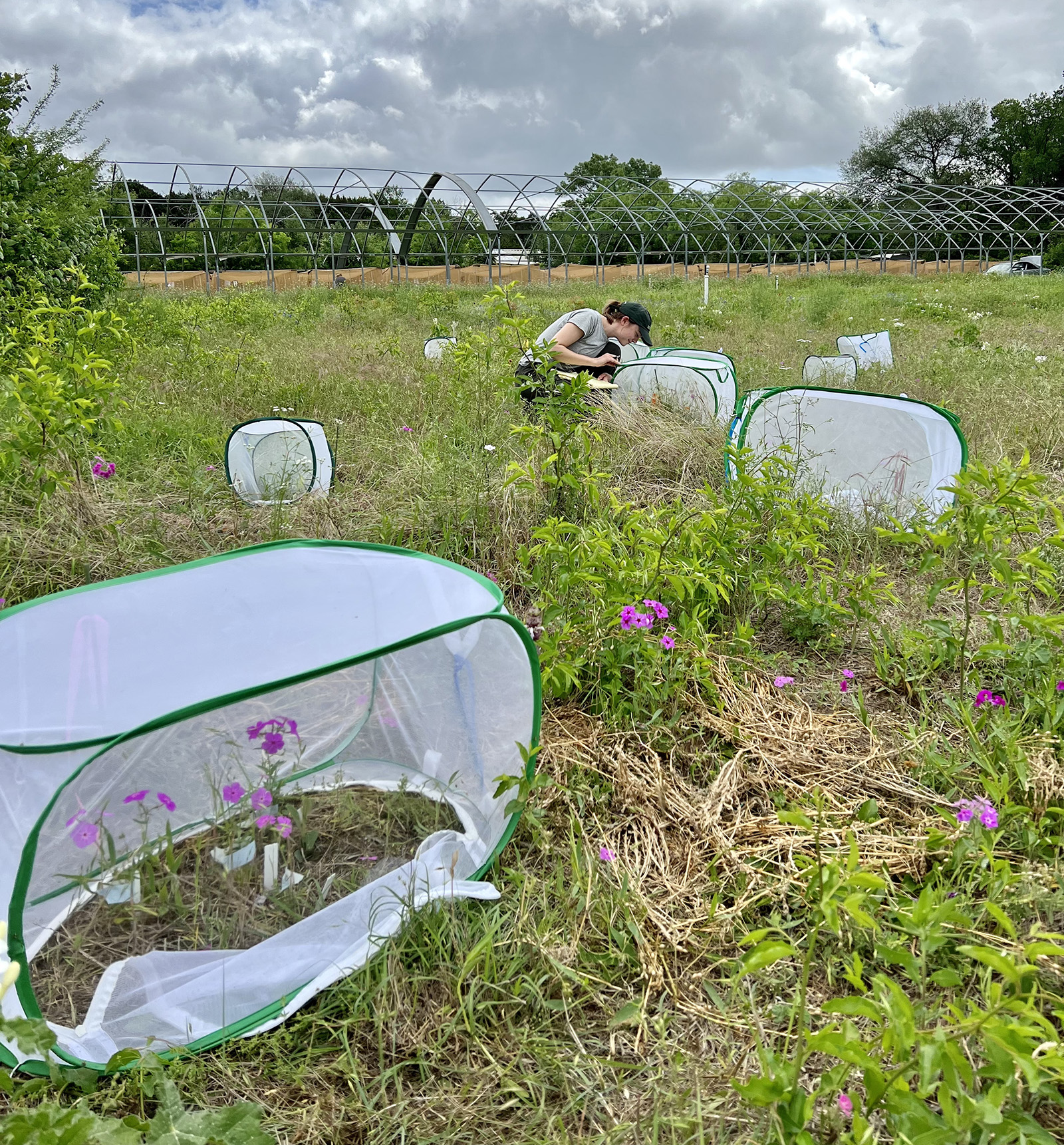The Hopkins Lab explores the role of plant and insect interactions in biodiversity
It is sunrise in Austin, Texas, and already the day is growing hot. Three groggy Arnold Arboretum scientists drive out of the city and into ranchland, stopping at a point on the map that appears to be nothing more than a roadside. The unmown margin is dotted with wildflowers in vibrant shades of yellow, orange, red, blue, and pink; their faint nectar mingles with the stronger aromas of damp grass and hot coffee. The three sit in camping chairs just across the fence from a pair of grazing cows, clipboards ready on their laps. Then they watch.
Nothing yet—it appears that even the pollinators don’t rise this early. “7:58 AM,” Grace says, half a joke and half a prayer. “They always come at 7:58 on the dot.” And sure enough, just before the turn of the hour, a dash of black appears over the pale blue sky. Fluttering closer, swooping and diving, teasing its way over the grasses until finally it reaches the bright pink, 5-petaled flowers at the center of the scientists’ attention. Rhythmically the butterfly alights on each one, folding its black and blue wings to reveal an arc of orange spots. It moves purposefully from pink flower to pink flower, proboscis unrolled and reaching down the flower tubes to feed, emerging from each with a dusting of vivid yellow pollen.

Grace Burgin is working in the field in Texas visiting Phlox populations to conduct a series of pollination experiments with fellow PhD candidate Austin Guy-Garner and her mentor, Associate Professor Robin Hopkins (Associate Professor of Organismic and Evolutionary Biology at Harvard University and Faculty Fellow of the Arnold Arboretum). Grace seeks to parse out the processes underlying observed patterns of plant-pollinator interactions in Texas Phlox by testing the effectiveness of Battus at each stage of pollination. Observations from sunrise to sunset confirm that Battus visits P. drummondii much more than any other daytime pollinator. An exclusion experiment reveals that nighttime pollination and self-pollination are insignificant in comparison. A foraging experiment with captive butterflies—caught skillfully with a hand net—quantifies how well Battus transfers pollen from flower to flower. Finally, a count of fruits developing after pollination shows how well pollen transfer by Battus produces seeds for the next generation.

With these observations confirming Battus as an effective primary pollinator of Phlox, Grace can investigate broader questions of how pollinators drive variation and evolution in plants. These kinds of plant-pollinator interactions are essential for much of the food we eat and the stability of our ecosystems, and they offer key insight into how flowering plants maintain their diversity. With biodiversity threatened by human impacts like habitat destruction and climate change, it is important to understand how changes to these interactions will affect future variation within and between species.
Grace’s work is just one facet of ongoing research on plant evolution and speciation in the Hopkins Lab at the Arnold Arboretum. From the genetic mechanisms that cause mutations in traits like flower color to the rise of new flower colors through pollination syndromes, the Hopkins Lab tackles an overarching question of how species evolve and maintain their identities across shifting patterns of interaction with their pollinators and their environments.

Another postdoctoral candidate, Anna Feller, works on the other side of the country as well as the other side of the spectrum of Hopkins Lab research. While Grace hones in on the microevolutionary relationship between two Phlox species in Texas, Anna looks broadly at the reproductive barriers among many species of perennial Phlox in the Midwest. Anna is also motivated by questions of how biodiversity evolves and is maintained, focusing in particular on the evolution of barriers like pollinator difference and microhabitat as well as incompatibilities that prevent species from interbreeding.
Anna spends this field season combing parks, preserves, and roadsides for Phlox populations, which will allow her to estimate the movement of their genetic material across the landscape. Vegetative cuttings she snips from the tips of plants are wrapped in wet paper towels, sealed in plastic bags, and packed together to be shipped to the Arboretum’s Weld Hill Research Building. There her lab mates tuck them into soil and propagate them into new plants in the research greenhouses, where they will grow and contribute to ongoing research for years to come.

Though each member of the Hopkins Lab approaches it from a different angle, we are all interested in the processes that create and sustain biodiversity in flowering plants. As Grace points out, biodiversity is important for both known and unknown reasons—while we know that diverse species provide us with food, ecosystem stability, and other services, we can only imagine what a particular species or a particular wealth of species might offer in the future. We can only attempt to predict what our impact on the globe and on biodiversity will do to that potential.
Returning from roadside populations of Phlox and firewheels to the verdant pathways of Arnold Arboretum, we are reminded once more of why care about and investigate plant diversity. Flowering plants you encounter at the Arboretum are powerful not just in their potential for answering questions of adaptation and evolution, but in their exceptional beauty and capacity for healing. For this we strive to make our parks and our world a beautiful and biodiverse space accessible to all, and work to understand what makes this diversity both possible and essential.